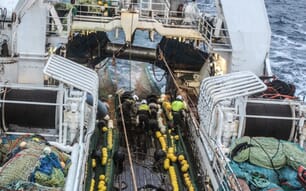According to Usagnet, Alaska fisheries haven't always been considered a model for the world. As demand for Alaska seafood increased in the first half of the 20th century, distant and loosely regulated federal management began depleting wild seafood stocks and by the 1950's Alaska salmon runs were declared a federal disaster, reportes Usagnet.
Highly efficient federally approved fish traps were partly to blame for the decline, and also limited jobs for local fishermen. This fueled the fishermen's desire for statehood and guided many of the principles of sustained yield, local area management, and public participation in the regulatory process to ensure sustainable returns for the future.
With great foresight and intentions to preserve and rebuild the valuable Alaska seafood industry, the framers of the Alaska Constitution mandated that "fish ... be utilized, developed, and maintained on the sustained yield principle." In 1959, as Alaska became a state, it experienced one of the lowest salmon runs since the turn of the century, at just 25 million fish. Conversely, in 2007 Alaska celebrated the fourth largest (sustainable) salmon harvest in a century, with over 212 million fish.
"Early on, state regulators separated the science of determining appropriate harvest levels from decisions on who gets the opportunity to harvest," Denby Lloyd, current Commissioner of the Alaska Department of Fish and Game told Usagnet. "And, decision-making on the in-season control of harvests is delegated to local area managers, those closest and most familiar with resources on the grounds and the fleets pursuing them. By distinguishing conservation from allocation, and by delegating in-season management authority to the local level, we have created a robust and successful model for sustainable fisheries management."
Today, Alaska's major fisheries (salmon, whitefish and shellfish) are some of the most productive and pristine sources of wild-caught seafood on the planet. After 50 years, the seafood industry remains a leading private sector employer and contributes roughly $90 million per year to state and local government coffers.
50 Years of Fish: An Alaskan Story of Success
US - Alaska celebrated 50 years of sustainable seafood management over the weekend, in what is a story of of great success and expansion.




